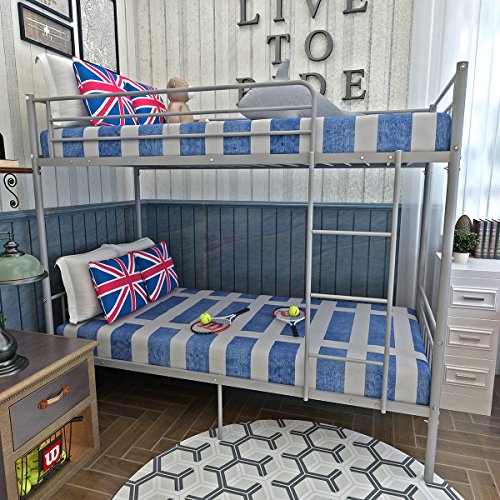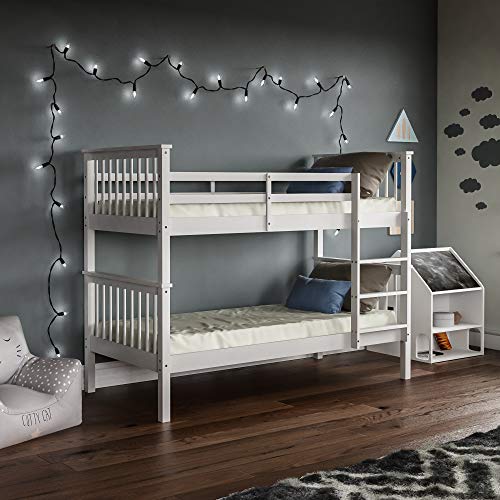Bunk Bed And Single Bed Tools To Streamline Your Everyday Lifethe Only…
페이지 정보

본문
 Choosing Between a bunk bed and single bed (additional reading)
Choosing Between a bunk bed and single bed (additional reading) When you are deciding on bunk beds or single bunk bed white beds, it is important to consider the mattress size and the options. Twin-sized mattresses are great for children who are small or adult single high bunk bed sleepers. They are best suited to rooms measuring 7 feet by 10 feet.
When you are deciding on bunk beds or single bunk bed white beds, it is important to consider the mattress size and the options. Twin-sized mattresses are great for children who are small or adult single high bunk bed sleepers. They are best suited to rooms measuring 7 feet by 10 feet.Families with children of various ages will benefit from a twin over full bunk. Another option that is popular is the futon bunk bed that separates into singles that includes a lower Western-style futon that transforms into bed.
Space Saving
Bunk beds can offer a unique solution for households seeking to maximize room space. This kind of furniture allows families to put two beds in the same room without using the floor space which could be used to store other furniture like dressers and desks.
Bunked beds are an excellent choice for kids' rooms, since they can provide more space to play and study. They also make room in smaller living spaces. They are also an ideal alternative to single bed frames for adults. Bunkbed owners who are savvy can incorporate accessories and decor to their beds that will make them feel more like home.
The primary benefit of bunk beds is that they permit children to share rooms and sleep in the same room with their parents. This arrangement can reduce conflicts in the home by permitting children to share a room. This arrangement can increase the amount and variety of storage space in a child's bedroom by eliminating the need for large furniture like dressers.
There are many kinds of bunk beds. However they all have the same designs that maximize space. Standard bunk beds feature two mattresses of the same size stacked on top of each other. A full-sized twin bunk bed is set up the same way but features two full-size mattresses on the bottom and a twin size mattress on the top. A futon bunk, which is a regular bunk mattress single bed, paired with an western-style futon sofa that can be converted into a sofa, is also an ideal choice for families looking for an elegant, space-saving bunk bed.
While bunk beds are a less expensive alternative to single beds, they could require more frequent maintenance and repairs due to their multi-tiered structure. Bunk beds may also be less accessible to those with mobility problems or those at risk of falling than single beds. It is crucial for healthcare facilities to weigh initial costs and long-term value when choosing the best bedding solutions for their facility.
Single beds are less costly to maintain and easier to repair than bunk beds. They can also be moved to meet the needs of patients or accommodate changes to room layouts. This flexibility is especially beneficial for behavioral health facilities that have to accommodate patients from a variety of demographics.
Convenience
Bunk beds are an ideal solution for families with children of different ages. A twin over full bunk arrangement is great for siblings with different sleeping preferences. For example, younger kids might prefer sleeping close to their parents, whereas older children may enjoy sleeping on their own.
Bunk beds also help save money as they decrease the number of mattresses that have to be purchased. Some bunk beds also have a built-in system of storage, which eliminates the need for separate dressers. This reduces clutter in patient rooms and maximize space.
Bunk beds also can help improve the bed capacity of the facility. They are ideal for cramped rooms, such as rehabilitation and youth psychiatric facilities, where patients share accommodations. They can also be used to accommodate large groups of residents in long-term care facilities.
While bunk beds provide a variety of advantages, they can be more challenging to clean and maintain than single beds. The additional stress on frames and joints could cause wear and tear, which requires more frequent inspections and maintenance. The bunk bed design may also pose accessibility issues for those with mobility issues or other health issues. The climb up and down the ladder can be challenging and even dangerous especially for older people.
Single beds are, however they can be rearranged to accommodate different layouts in rooms and give patients a more personalized environment. Journal of Environmental Psychology states that this flexibility increases the level of satisfaction of the occupant by 25 percent.
Be aware of your patient's demographics, your space limitations and your maintenance needs when choosing the ideal bed for your facility. Bunk beds are an excellent solution for facilities that wish to conserve space and need less setup time, while single beds are an excellent option for rooms that have high turnover rates or small budgets.
If you are considering a bunk bed, make sure to select a bed that has a clean mattress. The most suitable mattresses for bunk beds are latex, innerspring memory foam, or hybrid. However, some patients prefer futons. Verify that the mattress on a bunk bed is upholstered or slatted. A slatted bunk bed has the slats that are on the base, or slat rolls, which are screwed or hammered to support the mattress.
Safety
Bed safety is a major consideration when furnishing health care facilities. Bunk beds have the potential to create a safe and secure environment for patients, by efficiently using space while minimising risk. They can also lower the risk of injury due to their lower centers of gravity, which is ideal for people who are elderly and physically challenged.
Regular maintenance and a proper assembly are the keys to bunk security. Check for any weak or unstable parts and reinforce any weak points to prevent structural failure. Adhere to manufacturer-recommended weight limits, as excess loading can compromise stability. To avoid entrapment or falling ensure that ladders are properly attached to the frame.
Children are allowed to sleep on the top bunk only after demonstrating their ability to safely climb up and down. They should also be able manage their personal hygiene without supervision or assistance such as by going to the bathroom and getting dressed. In addition, bunk beds must be positioned far enough away from windows to reduce the risk of injuries resulting from window access.
One drawback of bunk beds is their ineffective motion and noise isolation, which can be a problem for sleepers with light sleepers. Sleepers on the bottom bunk may feel their counterparts tossing and turning in their beds or hear them swaying up and down at night.
Single beds, however, provide better sound and motion isolation. They are also versatile enough to accommodate a variety of patient demographics, and room sizes.
The budget and the particular needs of the facility will determine which bed type to select. A bunk bed is a cost-effective option for healthcare facilities with limited space and a high patient turnover rate, while single beds are ideal for long-term care facilities and rehabilitation centers with consistent populations. It is crucial to consider the initial cost versus the long-term benefits and put the emphasis on the comfort of the patient and security. Regular inspections and timely maintenance are vital for all beds, regardless of kind. The Facilities Management Journal reports that proactive maintenance strategies can reduce repair costs by up to 15 percent.
Functionality
In addition to the obvious space-saving benefits, bunk beds can also help to create a sense between siblings or other friends who share the same room. They are ideal for families with children of different age groups, or for multiple children sharing a space. They can also be utilized in youth psychiatric or rehabilitation facilities where patients must be able to sleep together in groups.
Bunk beds are available in various configurations, and some even have built-in storage. Twin over full bunks, which are extremely popular with their twin mattresses at the bottom and a double on top. This is ideal for families with children of different age groups or for adults who wish to share a bed with a spouse or friend. L-shaped bunks can also be an elegant alternative to the classic bunk layout with the lower part of the unit containing a futon that can be used as a couch or rearranged to create the double bed.
Bunk beds are more space-efficient but they also require more maintenance due to their multi-tiered design. The Facilities Management Journal highlights that this could include frequent inspections and repairs to ensure security. Single beds are cheaper and easier to maintain.
Another factor to consider when selecting bunk beds is that they usually offer less privacy than single beds, since guests share their immediate space with someone else. Some individuals may be unable to do this, particularly in shared housing settings such as rehabilitation centers or transitional homes.
Single and bunk beds can be customized with additional features like desks or storage solutions to create a more efficient sleeping space. This is particularly useful in small spaces that need to make the most of their space. They can help to eliminate clutter and free up space on the floor for other activities or furniture. Some bunk beds can be divided into two single bunk bed with trundle beds, allowing them to adapt to the needs of the child and continue providing the comfort of a lifetime.
- 이전글Chemistry service man essays 24.11.14
- 다음글Исследуем вселенную казино веб-казино Аврора 24.11.14
댓글목록
등록된 댓글이 없습니다.




